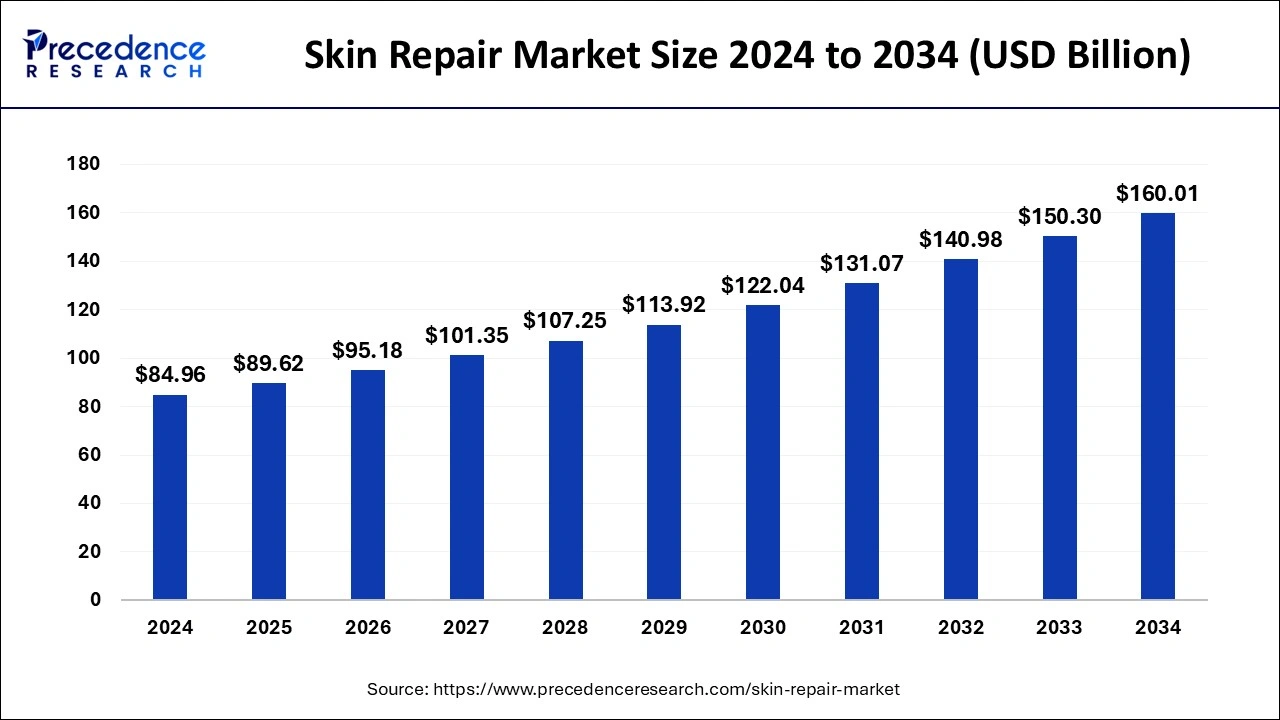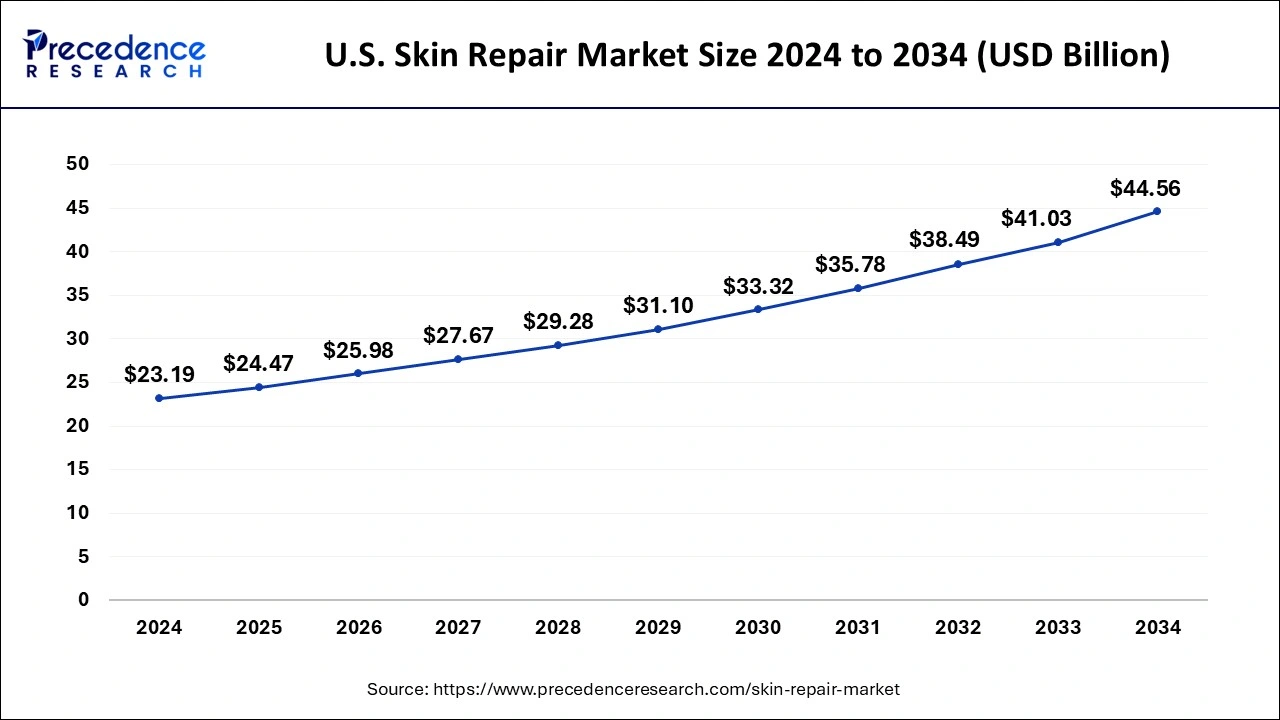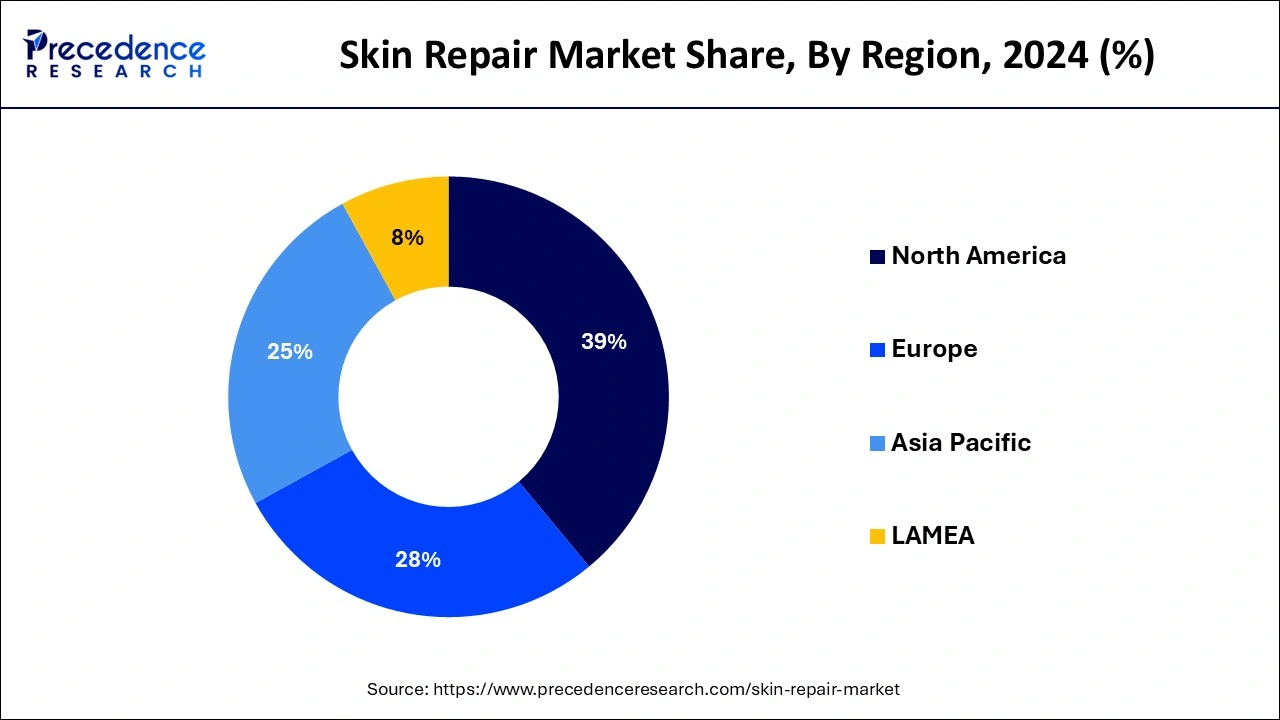Skin Repair Market Size and Growth 2025 to 2034
The global skin repair market size was estimated at USD 84.96 billion in 2024 and is predicted to increase from USD 89.62 billion in 2025 to approximately USD 160.01 billion by 2034, expanding at a CAGR of 6.54% from 2025 to 2034.

Skin Repair MarketKey Takeaways
- The global skin repair market was valued at USD 84.96 billion in 2024.
- It is projected to reach USD 160.01 billion by 2034.
- The skin repair market is expected to grow at a CAGR of 6.54% from 2025 to 2034.
- North America has generated the largest market share of 39% in 2024.
- By product type, the topical creams and ointments segment has captured the biggest market share of 30% in 2024.
- By product form, the ointments segment led the market with a major market share of 30% share in 2024.
- By application, the diabetic foot ulcers segment has contributed 24% of the market share in 2024.
- By distribution channel, the hospital pharmacies segment has contributed the largest market share of 33% in 2024.
- By end-user, the hospitals and clinics segment dominated the market with the maximum market share of 53% in 2024.
U.S.Skin Repair Market Size and Growth 2025 To 2034
The U.S. skin repair market size reached USD 23.19 billion in 2024 and is anticipated to reach around USD 44.56 billion by 2034, poised to grow at a CAGR of 6.75% from 2025 to 2034.

North America has its largest market share of 39% in 2024 in the skin repair market. To effectively reach consumers, skincare brands in North America significantly invest in marketing and distribution tactics. This covers social media influencers, internet marketing, dermatologists, and collaborations with aesthetic specialists. Technology is being used in skincare products and services more and more. Improving the overall patient experience and treatment results involves utilizing telemedicine platforms, tailored skincare products, and artificial intelligence.
- In November 2023, the clinical-stage regenerative medicine startup ChitogenX Inc. recently revealed the launch of a new development program aimed at addressing significant medical gaps in the burn and skin restoration sector, which is estimated to be worth US $19 billion and is expected to increase at a compound annual growth rate of 5% until 2032.

Asia-Pacific is the fastest-growing in the skin repair market during the forecast period.Increased disposable income levels in numerous Asia-Pacific nations have given customers additional purchasing power for skin care products, notably those aimed at skin restoration. People will spend a large percentage of their income on skincare products that claim to treat skin issues and restore damage as they grow more self-conscious about their appearance and general health. These nations have a rich cultural history that highly emphasizes beauty and skincare. Due to this cultural influence, skincare businesses and products that provide cutting-edge formulations customized to address skin concerns, including repair, have increased.
- Summertime temperatures can make our skin more vulnerable to sunburn, heat rash, and other issues. Burn injuries are more frequent during these sweltering summer months because of mishaps like fires, electrical burns, and sun overexposure.
- The World Health Organization reports that over a million Indians have mild to severe burns each year.
- Since collagen wound care dressings provide a soft, malleable layer, promote rapid healing, and are non-stick, they are suitable for treating painful burns.
Market Overview
The segment of the healthcare and cosmetics industries that concentrates on creating goods and services meant to restore and revitalize skin is known as the skin repair market. This market includes various goods, such as medical gadgets, skin care creams, lotions, serums, and ointments.
The goal is to provide customers with ways to enhance their skin's function, beauty, and health. This market caters to people who want to keep their skin appearing young and healthy and those with specific skin issues or illnesses that need to be treated by a doctor. To support healing, collagen synthesis, and general skin health, skin restoration products and treatments frequently work to hydrate, nourish, protect, and rejuvenate the skin cells.
- In 2022, Mayo Clinic distributed $53 million to patients under its financial assistance policy, according to the nonprofit tax filings of the health organization.
Skin Repair Market Data and Statistics
- In chronic wounds, Cutting-edge bandages replenish skin tissue, tackle the dysregulated inflammatory phase, and guard against infection.
- Researchers have found a low-cost anti-inflammatory hydrogel that may one day be used to treat chronic skin lesions like those found in diabetics.
- In 2023, the Indian Drugs Controller certified the first tissue engineering scaffold made locally using animal-derived materials to treat skin lesions with the least amount of scarring.
Skin Repair MarketGrowth Factors
- The growing number of people suffering from skin problems such as psoriasis, acne, eczema, and others is driving demand for skin healing products.
- Growing awareness of UV radiation's detrimental effects increases the market for sunscreens and sun-damage-repair treatments.
- Plant-based skin repair solutions are gaining popularity because consumers choose skincare products with natural and organic ingredients.
- Consumers prioritize skincare and other self-care routines, which has created a massive market for skin-healing products, promoting the expansion of the skin repair market.
- The number of people who are becoming older is increasing, which raises the need for solutions that address wrinkles, age spots, and decreased skin suppleness.
Market Scope
| Report Coverage | Details |
| Growth Rate from 2025 to 2034 | CAGR of 6.54% |
| Market Size in 2025 | USD 89.62 Billion |
| Market Size by 2034 | USD 160.01 Billion |
| Base Year | 2024 |
| Forecast Period | 2025 to 2034 |
| Segments Covered | By Product Type, By Product Form, By Application, By Distribution Channel, and By End-user |
| Regions Covered | North America, Europe, Asia-Pacific, Latin America, and Middle East & Africa |
Market Dynamics
Drivers
Rising awareness of skincare
Several variables have contributed to this increasing awareness, such as the ease with which information can be accessed via social media and the Internet and the growing emphasis on wellness and self-care. Customers are growing more informed about preserving good skin and guarding against aging, stress, and environmental damage. Because of this, there is a rising need for skincare products and procedures that cure current skin conditions, stop further damage, and advance general skin health. Innovative skincare formulas, cutting-edge treatments, and customized skincare routines catered to specific requirements have all been developed due to this trend. Thereby, the rising awareness of skincare is observed to act as a driver for the skin repair market.
Consumers preference for non-invasive procedures
Customers worried about possible consequences or side effects may find non-invasive procedures more enticing than invasive surgeries because they usually carry less risk. Non-invasive procedures typically result in less pain or discomfort than intrusive surgeries, which can cause discomfort and anguish. This makes the experience for the patient more favorable.
Restraint
Limited efficacy of current treatments
Despite developments in skin care products and medical technology, many of the current skin repair treatments, including creams, ointments, and even some medical procedures, frequently fall short of providing adequate results for various skin disorders and injuries. This insufficiency can be ascribed to multiple variables, including gaps in our knowledge of skin biology, individual differences in therapy responsiveness, and limitations in the efficacy of existing treatments.
Skeptical behavior of consumers about skin care products
As for prior skincare product failures to live up to expectations, consumers may be skeptical of skincare products' efficacy, particularly those that claim skin healing or rejuvenation. Consumer confidence can be undermined, and suspicion over the safety and effectiveness of skincare products can be increased by reports of dangerous substances, product recalls, or scandals within the industry. Many skincare products are available in the market, claiming to be the finest for repairing damaged skin. Customers may become overwhelmed by various options and become skeptical of the effective items. Such skepticism is observed to act as a restraint for the skin repair market.
Opportunities
Growing demand for anti-aging products
The demand for treatments that claim to lessen wrinkles, fine lines, and other symptoms of aging is rising as the population gets older and more mindful of keeping a young appearance. This trend, along with skincare technology improvements and an increased focus on personal hygiene and self-care, is driven by rising disposable incomes. Thus, by providing cutting-edge and potent anti-aging remedies, skin repair product manufacturers can profitably enter this attractive market niche. To capitalize on the increased customer interest in keeping youthful and bright skin, this involves creating products with components that have been scientifically proven to work, tailored formulas, and engaging marketing techniques.
Expansion of distribution channels
Diversifying distribution channels allows businesses to reach previously untapped geographic regions and underserved groups. These channels include pharmacies, specialty skincare boutiques, retail stores, and internet platforms. Increasing distribution networks makes it easier for businesses to enter new markets. For instance, breaking into untapped foreign markets or concentrating on specialty consumers with possible distribution preferences. It is more convenient for customers to obtain skin-healing items when there are several ways to buy them. This ease of use can potentially boost sales and foster brand loyalty.
Product Type Insights
The topical creams and ointments segment dominated the skin repair market with the largest share of 30% in 2024. Topical creams and ointments are made with active chemicals that specifically address dryness and skin irritation issues. Depending on the intended purpose, they frequently contain steroids, moisturizers, anti-inflammatory medicines, antibiotics, and antifungals. Because of its adaptability, customers can use a single product to treat various skin conditions. In addition to treating skin conditions, it provides cosmetic advantages such as hydration, wrinkle and fine line reduction, and skin tone and texture improvement. Customers looking for skincare products with both medicinal and cosmetic benefits are drawn to this dual purpose.
Topical creams and ointments provide targeted treatment by being administered directly to the afflicted area, in contrast to oral drugs or systemic therapies. Many customers choose them because of their tailored approach, which maximizes efficacy while minimizing systemic adverse effects, especially for people with mild to moderate skin conditions.
The wound care products segment acted as the second largest segment in the skin repair market. A healthy market for wound care products is required due to the high frequency of wounds and injuries. There is always a need for efficient ways to speed up the healing process, whether for small cuts and scratches or more significant injuries like burns and ulcers. Athletes who are vulnerable to sports injuries, older populations with a higher risk of chronic wounds, and people having surgery all contribute to this demand.
Furthermore, the need for enhanced wound care solutions has been fueled by the increased prevalence of chronic illnesses like diabetes, obesity, and vascular disorders. These illnesses frequently leave behind complicated wounds that need to be treated with specific techniques to avoid complications and promote healing. As a result, producers have concentrated on creating cutting-edge items designed specifically for long-term wounds, such as sophisticated dressings with attributes like moisture management, antibacterial capabilities, and prolonged release of medicinal ingredients.
Product Form Insights
The ointments segment dominated the skin repair market with a share of 30% in 2024. Ointments are designed to treat various skin conditions, such as psoriasis, eczema, burns, scrapes, and dryness. Because of their adaptability, they may be used to treat both mild and severe skin diseases, which appeals to a wide range of customers. In the skincare business, consumer perceptions of efficacy play a significant role in determining purchase decisions. Customers assume these can produce noticeable benefits because they are frequently linked to intense care and deep moisturization, particularly for complex skin concerns. This view is further reinforced by positive word-of-mouth experiences, which sustain demand for ointment-based goods. The capacity of ointments to retain moisture is a significant factor in their efficacy.
The creams segment is the fastest growing in the skin repair market during the forecast period. Cream-based formulas are quite popular among customers looking for efficient skin rejuvenation and repair options. Creams provide a practical and user-friendly way to address various skin concerns, from dryness and irritation to issues associated with aging, thanks to their smooth texture, ease of application, and quick absorption.
The dynamic evolution of cream-based skincare products is driven by strategic innovation in formulation technology and ingredients. Manufacturers engage in research and development activities to combine cutting-edge components known for their skin-repairing, moisturizing, and anti-aging qualities, such as retinoids, hyaluronic acid, peptides, and botanical extracts. These developments increase the effectiveness of the product and increase consumer confidence.
- In November 2023, Northwestern University researchers created a synthetic melanin lotion that shields the skin from UV rays and heals damaged skin.
Application Insights
The diabetic foot ulcers segment is the fastest growing skin repair market during the forecast period. Millions of people worldwide suffer from diabetes, which has reached epidemic proportions. Foot ulcers are one of the most crippling effects of diabetes, and if left untreated, they can result in severe infections and even amputations. Diabetic foot ulcers are becoming more common as the number of people with diabetes rises, calling for efficient management techniques and therapies.
According to the National Library of Medicine, more admissions for diabetic foot ulcers occur than for any other diabetes condition. In the US, diabetes is currently the primary cause of non-traumatic amputations. In all, 5% of diabetic individuals get foot ulcers, and 1% must have their feet removed.
Distribution Channel Insights
The hospital pharmacies segment dominated the skin repair market with the largest market share of 33% in 2024. Highly qualified pharmacists and medical specialists with an in-depth understanding of dermatological disorders and available treatments work in hospital pharmacies. Because of their experience, they can accurately determine the patients' skin-healing needs and recommend suitable goods or drugs. The prescription, dispensing, and monitoring procedures are streamlined by their frequent integration with electronic health record systems and other healthcare infrastructure. By enhancing coordination and communication amongst healthcare professionals, this integration improves patient outcomes when managing skin repair difficulties.
The retail pharmacies segment held the second largest share in skin repair market with share of 29% in 2024. Retail pharmacies are frequently found next to medical facilities, shopping malls, or residential areas. This convenience feature is crucial because it makes it easier for customers to purchase skincare products, including skin repair solutions, from these stores. Unlike specialty clinics or dermatological offices, which may have limited hours or require appointments, pharmacists usually provide convenient extended walk-in service, improving accessibility.
Customers can select from various formulations tailored to their skin concerns, such as moisturization, wound healing, scar reduction, or anti-aging, thanks to the market's diversity in the skin repair industry. Pharmacies satisfy consumer brand affinities and budgetary preferences by stocking branded and generic goods.
End-user Insights
The hospitals and clinics segment dominated the skin repair market with a share of 53% in 2024. Many medical professionals, such as dermatologists, plastic surgeons, and wound treatment specialists, are usually found in hospitals and clinics. These doctors are skilled in diagnosing and treating complex skin disorders, from tiny abrasions to severe burns. A multidisciplinary approach is frequently used for skin repair, combining different medical specialties such as dermatology, plastic surgery, wound treatment, and nutrition.
Hospitals and clinics provide comprehensive treatment by giving patients access to many specialists and support services under one roof. It is essential for handling emergencies involving severe burns, traumatic injuries, and other urgent skin disorders that need to be treated right away. Their supremacy in the skin restoration industry is mainly attributable to their capacity to offer emergency care around the clock.
Skin Repair Market Companies
- Solta Medical
- Lumenis
- Cynosure
- Strata Skin Sciences
- Syneron Candela
- Lutronic
- Cutera
- Lynton
- Sciton
- NeoAsia
- Venus Concept
Recent Developments
- In June 2022, The POPxo Suncare range was introduced exclusively by MyGlamm as part of POPxo, the most prominent digital community of millennial women in India, and it further broadened its product offerings in the personal care and beauty industry with the introduction of their new product campaign, #ekdoteenapplysunscreen. Six products comprise the unique and revolutionary POPxo Suncare line of sun care solutions designed to shield customers from sun damage.
- In March 2022, TriLift is a facial activation instrument that targets the three aging components of structure, texture, and contour by treating all three layers of tissue of the muscles: the dermal layer and the epidermal layer. Lumenis Be, Ltd. is an established energy-based medical equipment business for aesthetic and eye care uses.
Segments Covered in the Report
By Product Type
- Topical Creams and Ointments
- Moisturizers and Lotions
- Serums and Elixirs
- Wound Care Products
- Skin Repair Devices
By Product Form
- Creams
- Ointments
- Gels
- Pads and Dressings
- Other Forms
By Application
- Burns
- Diabetic Foot Ulcers
- Surgical Wounds
- Traumatic Wounds
- Pressure Sores
- Others
By Distribution Channel
- Retail Pharmacies
- Online Retail
- Hospital Pharmacies
- Specialty Stores
- Others
By End-user
- Hospitals and Clinics
- Home Care Settings
- Skincare and Aesthetic Centers
- Others
By Geography
- North America
- Europe
- Asia-Pacific
- Latin America
- Middle East and Africa
For inquiries regarding discounts, bulk purchases, or customization requests, please contact us at sales@precedenceresearch.com
Frequently Asked Questions
Ask For Sample
No cookie-cutter, only authentic analysis – take the 1st step to become a Precedence Research client
 sales@precedenceresearch.com
sales@precedenceresearch.com
 +1 804-441-9344
+1 804-441-9344